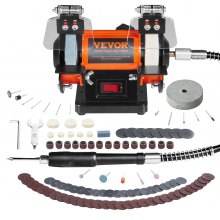

The art of buffing, a process that involves polishing and refining surfaces to achieve a smooth finish, has been an integral part of various industries, ranging from automotive to metal fabrication.
The transformative potential of buffing machines enables them to elevate the overall quality of products. Whether it is a metal component, artifact, or even an automotive surface, a buffing machine can take it from ordinary to extraordinary real quick!
VEVOR, seeing the unlimited potential of the buffing machine, starts a quest to ensure affordable, high-quality ones are always available. From our online stores to Amazon stores, VEVOR’s buffing machines lead.
Buffing machines have a wide range of applications, making it possible for you to see them with various types of people. From small hobbyists to everyday professionals, the possibility of who uses the buffing machine is limitless. In fact, anywhere you can think of an excellent finish, there is a buffing machine.
Whether in automotive manufacturing or maintenance, you can find a buffing machine with automotive professionals of different kinds. Car body manufacturers help use the buffing machine to ensure the vehicle has the premium finish they desire. They also use buffing machines in automotive maintenance shops to eliminate scratches, swirls and imperfections.
Professionals who work on metal components, even for other industries like aerospace, use buffing machines to achieve the perfect glossy finish to sell their products. Woodworking professionals also use them to enhance the appeal of wooden surfaces. They remove imperfections and help apply finishes like lacquer or wax, bringing out the natural beauty of the wood and providing a smooth and lustrous finish.
Jewelers use buffing machines to polish and refine precious metals like gold, silver, and platinum. They also use them to shape and smoothen gemstones to achieve their desired luster. The high precision of these machines allows for intricate detailing on jewelry pieces, contributing to the final aesthetic appeal of the products
Experts in the construction and architectural industry use buffing machines to polish various aspects of their works. From metal handrails to decorative materials, the uses of buffing machines in this industry are limitless.
Buffing has various applications, making it capable of helping different surfaces to achieve suitable finishes. Each surface is familiar in different industries and typically needs different buffing machine types. Here are some materials a buffing machine can easily make better:
Buffing machines can work on different metal types, including brass, aluminum, copper and other alloys. They help achieve a polished, smooth, and reflective surface on metal components used in automotive parts, jewelry, aerospace components, and more.
Buffing machines help wooden materials achieve the best surface there is. Whether soft or hardwood, buffing machines can help improve its quality and bring out its aesthetic appeal.
Although delicate, buffing machines can work on glasses without compromising their integrity. Instead, it smoothens glass and reduces sharp edges.
Buffing machines can polish natural stones like granite and marble to enhance their appearance, making them suitable for different applications. It can also polish and refresh ceramic tiles, surfaces, and decorative pieces.
A buffing machine can also work on plastic, composite, leather, rubber, and carbon fiber materials.
DIY buffing is widely embraced and can be used to sort little tasks into bigger ones. However, not knowing what to look out for when doing a DIY buffing can cause a significant problem, leading to accidents and injuries. Here are some potential pitfalls during DIY buffing and how you can avoid them:
Choosing the wrong type of buffing wheel or abrasive compound for the material can result in ineffective buffing or damage. Also, excessive buffing pressure or long buffing time can cause overheating, material damage and distortion.
Follow the recommended buffing time, and match the wheel and compound to the material being buffed.
Failure to secure the workpiece can lead to accidents, such as the workpiece being thrown off the buffing table, and cause injuries. Ensure your workpiece is appropriately secured to the buffing machine to prevent problems.
Buffing generates dust and fumes that can cause respiratory problems in properly ventilated places. Therefore, ensure adequate ventilation of your buffing space.
Focusing on eliminating imperfections, VEVOR shows our commitment to aesthetics through a buffing machine dedicated to craftsmanship. It is no news that VEVOR never stops trying to develop. Therefore, you can expect constant improvement with many of us.
VEVOR designs its jet ski stands with the end user in mind. The equipment often features user-friendly interfaces, easy setup procedures, and intuitive controls, making it accessible to seasoned professionals and those new to the industry.
With a global presence, VEVOR has established a reputation as a reliable supplier worldwide. This global reach ensures customers can access VEVOR products and support services in various regions. VEVOR provides detailed product information, specifications, and user manuals, ensuring transparency in its offerings. Customers can make informed decisions based on the precise and accurate information the brand provides.
Yes, the automotive industry usually employs buffing machines for paint corrections. They can remove swirl marks, scratches, and other imperfections in the paint, restoring the vehicles to a high-gloss finish.
The frequency of changing the buffing wheels or pads depends on different factors. They include the type of materials being buffed, the buffing wheel’s abrasiveness level, and usage intensity. Always examine your buffing wheel to know when they are wearing out and can become less effective.
Buffing machines are versatile, and you can use them for industrial and DIY applications. The variety in sizes and capacities enable them to cater to different necessities, making them useful for small-scale home polishing and industrial buffing needs.